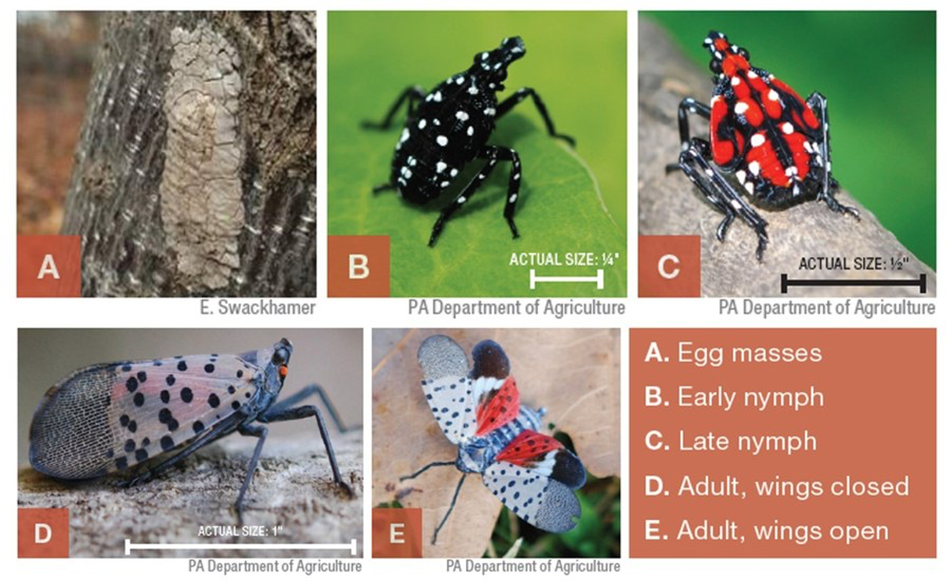By Patricia Houser
For Nature’s Sake

Patricia Houser
A typical workday for state scientist Claire Rutledge over the past year has included fieldwork in Milford at sites where she can reliably find swarms of spotted lanternfly. With a masters and doctoral degree in entomology, and research experience with such invasive pests as the emerald ash borer, Rutledge shifted last fall in her work for the Connecticut Agricultural Experiment Station to look at the lanternfly. That has led her to spend significant time in the perhaps less picturesque corners of Milford.
Some of the more predictably infested spots for lanternfly in the city – places that are also easily accessed for experiments and collecting samples – are so-called disturbed sites like roadsides or park-and-ride lots in the shadows of big highways. That’s partly because these places tend to also feature the invasive tree of heaven, an ecologically destructive, rapidly growing deciduous tree. The spotted lanternfly is especially attracted to the tree of heaven which, in turn, plays a key role in helping the lanternfly population to thrive.
For those who have not yet encountered the spotted lanternfly, an invasive insect originally from southeastern Asia, in the adult phase it looks like a lavishly decorated moth about one inch long and half an inch wide, featuring dusky wings with black spots in an outer layer and an underlayer with striking red, white and black coloring. From birth, it passes through four nymph stages, all of which are spotted and wingless; they’re great hoppers. By September they’ve transformed into adults, and through November or until the first killing freeze they’ll be laying eggs.

While spotted lanternfly doesn’t bite or sting humans or pets, it does feed “voraciously” on a range of food crops, hardwoods and ornamental plants, according to biologists at Penn State. They have mouth extensions that help them drain the nutrients from a range of plants – often to the point of stressing rather than killing the plant, although a large, persistent enough swarm can kill a tree. In general, experts consider them a threat to agriculture and tourism, and Rutledge points to the particular threat they present for vineyards.
The first spotted lanternfly infestation in the US occurred in 2014 in eastern Pennsylvania. Here in Connecticut, the first infestation was discovered in 2020, says Rutledge, clarifying that, “we call it an infestation when we find a population that’s reproducing – where we see evidence of adults and eggs.”
In New Haven County, she says, the first infested sites were at two highway rest stops: one in Milford on I-95 and one in Orange along the Wilbur Cross Parkway. That’s not surprising, since these bugs seem to spread by hopping on cars, trucks, trains or any other moving vehicle and then drop off when the vehicle comes to rest.
This insect’s tendency to hitchhike and accumulate where vehicles stop is also why residents of Milford and Orange will notice especially large numbers of spotted lanternfly at the CT Post Mall or train stations – there have been swarms sighted on the northbound side of the Metro-North station in Milford.
On her rounds to collect lanternfly samples, Rutledge visits a park and ride between the north and south ramps at Exit 40 of I-95, where she is dressed in head-to-toe fieldwork garb, prepared for dirt and thorns and wearing a vest for visibility. Her equipment in this case includes soda cups, the kind with domed lids and a small opening at the top. Those make an ideal receptacle for the 100 to 150 lanternflies that Rutledge will deliver to colleague Dr. Hany Dweck at the state lab.
Dweck, who has an expertise in chemical ecology, is studying the way that lanternflies detect odors as well as which odors are the best attractants. This kind of knowledge has been used to create traps at places where lanternflies lay eggs on trees near Old Gate Lane, Oronoque Road and other spots in Milford. Such oviposition traps are skirt-like devices attached a few feet off the ground, each with a different scent, that Rutledge and others measure for activity.
“We’re testing different smells to see what they like to lay eggs on,” she says.
That’s just one of several experiments which are helping Rutledge and her colleagues build a level of scientific expertise on lanternflies that can reassure us all. But these same experts will also warn against complacency.
Officials from affected states regularly assert at least five ways the public can help reduce the harm caused by spotted lanternflies. 1) Help scientists gather more data by using online reporting when and where you see a lanternfly or swarm. See the Connecticut Agricultural Experiment Station website for that link. 2) Squash or otherwise collect (some use a handheld vacuum) and dispose of the insect to prevent more egg-laying. Each female can lay at least two masses, and each egg mass consists of 30 to 50 eggs. 3) Scrape egg masses off of any surfaces around your property, including your car, and dispose of it in a sealed zip-lock with alcohol or hand sanitizer. 4) Check that you don’t help transport these pests. See the USDA’s online spotted lanternfly checklist. 5) Look for opportunities to eradicate the tree of heaven plant in your town. For background, view the three-minute video from Purdue Extension called, “ID that Tree: Tree of Heaven.”
Of the steps listed above, the one thing that may help most in the long run toward controlling this and other invasive insects is ridding your property and town of the tree of heaven. Still, especially now during egg-laying season, each one of the above actions can help protect local landscapes and ecosystems.
Patricia Houser, PhD, AICP, shares her exploration of local and regional environmental issues in this column as a member of the nonpartisan Milford Environmental Concerns Coalition.